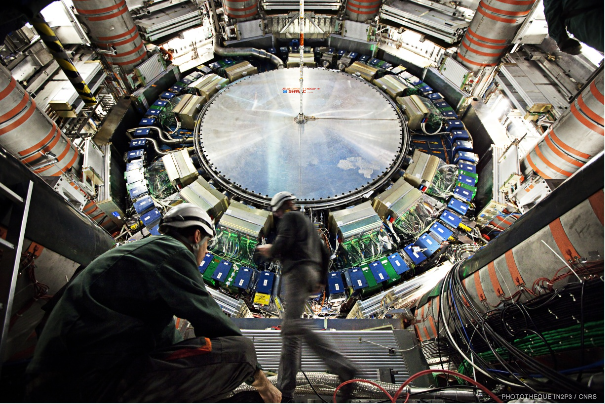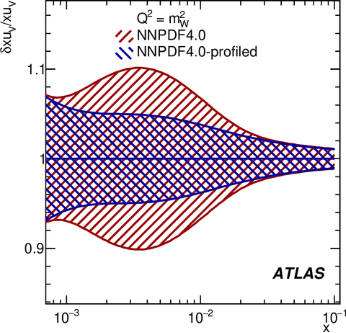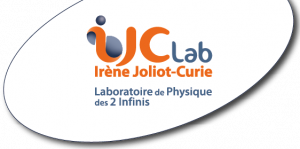
Researchers from the ATLAS group at IJCLab have achieved a significant milestone in understanding the electroweak sector of the Standard Model through high-precision measurements of W± boson properties. Photo credit: ATLAS - CERN /IJCLab.
Precision research on weak force carriers
For over 40 years, the W± and Z bosons, discovered at CERN's SPS collider, have been the subject of extensive studies by the scientific community. As mediators of the weak force, their precise characterization is essential for our fundamental understanding of particle physics.
Physicists from the ATLAS group at IJCLab have performed unprecedented measurements of single and double differential cross-sections for W± boson production (graph below) in proton-proton collisions at 5.02 TeV and 13 TeV.

These measurements were carried out using data collected by the ATLAS detector with integrated luminosities of 255 pb⁻¹ and 338 pb⁻¹ respectively, under exceptional experimental conditions with low pile-up.
Historical and scientific context
The discovery of W± and Z bosons in 1983 at CERN constituted a major confirmation of the Standard Model of particle physics. This discovery, which earned Carlo Rubbia and Simon van der Meer the Nobel Prize in Physics in 1984, demonstrated the unification of electromagnetic and weak forces in what we now call electroweak theory.
The W boson mass is particularly important because it is linked to many other Standard Model parameters, notably the mass of the Higgs boson discovered in 2012.
Outstanding scientific firsts in a competitive context
This research marks several firsts for the ATLAS collaboration in a field where measurement precision is crucial for testing the limits of the Standard Model:
- First measurement of single differential cross-sections as a function of lepton transverse momentum (pT)
- First measurement of double differential cross-sections
- First measurement at 13 TeV and improved measurement at 5 TeV for determining W boson charge asymmetries
These measurements from the ATLAS group at IJCLab complement and refine those previously performed by other international collaborations.
Results that surpass theoretical predictions
A notable aspect of this work is that the experimental measurements prove more precise than theoretical predictions calculated at NNLO (next-to-next-to-leading order) with NNLL (next-to-next-to-leading logarithmic) precision transverse momentum resummation, while remaining in good agreement with them.
NNLO and NNLL resummation represent the most advanced theoretical calculation methods currently available in particle physics. They enable highly precise predictions by including multiple levels of mathematical corrections and optimizing the treatment of complex terms.The fact that the obtained measurements exceed the precision of these state-of-the-art calculations highlights the technical excellence achieved and the importance of these new data.
This unprecedented experimental precision allows for further constraining theoretical models and potentially revealing subtle deviations that could indicate physics beyond the Standard Model. The search for such deviations is now a priority in the high-energy physics community, given that the Standard Model, despite its exceptional success, cannot explain certain phenomena such as dark matter or matter-antimatter asymmetry in the universe.
Impact on PDF knowledge in a broader perspective
The single differential cross-sections in pseudorapidity η have been used to study the impact of measurements on proton parton distribution functions (PDFs). This analysis shows that PDF precision can be considerably improved, particularly for valence quarks, by up to a factor of 2 in certain kinematic regions (figure below).

This improvement in our knowledge of PDFs has implications that extend far beyond W boson physics. PDFs are essential for predicting production rates of all processes at the LHC, including the production of hypothetical particles predicted by theories beyond the Standard Model. Better knowledge of PDFs therefore strengthens the sensitivity of new physics searches at the LHC.
Towards better determination of W boson mass and its implications
The single differential cross-sections in lepton transverse momentum pT show sensitivity to the W boson mass (mW). These new measurements can be used in a joint mW-PDF analysis allowing, for the first time, proper accounting of the correlation between these two parameters.
This methodological advancement is particularly important because precise measurement of mW is one of the most rigorous tests of the Standard Model. Indeed, the relationship between the masses of the W, Z, and Higgs bosons allows verification of the model's internal consistency. Any significant deviation could indicate the existence of new particles or interactions.
Recently, tensions have emerged between different measurements of mW, notably between results from the CDF experiment at Fermilab's Tevatron and those from CERN's ATLAS, CMS, and LHCb at the LHC. The new approach developed by the IJCLab group could contribute to resolving these tensions by offering a more robust method that explicitly accounts for uncertainties related to PDFs.
Methodology and exceptional experimental conditions
The publication reveals that these measurements were performed under particularly favorable experimental conditions. Data were collected during dedicated sessions in 2017 and 2018 with low pile-up of approximately 2 proton-proton collisions per beam crossing, about 20 times less than during normal LHC operations.
These unique conditions allowed excellent resolution in measuring hadronic recoil, a crucial parameter for this type of analysis. The experimental precision achieved is better than 0.5% in most of the phase space, excluding uncertainty related to luminosity measurement. Their exploitation doesn't stop there: an ongoing analysis aims to use them to obtain a precise and independent measurement of mW.
Future perspectives
These results open several promising research avenues:
- Exploiting these measurements for a more precise determination of W boson mass, properly accounting for correlations with PDFs.
- Using these improved constraints on PDFs to refine other measurements and searches at the LHC.
- Possible extension of this methodology to other electroweak processes, such as Z boson production to further test the Standard Model.
- Searching for subtle deviations from Standard Model predictions that could indicate new physics.
A major contribution from IJCLab in the international landscape
Members of the ATLAS group at IJCLab played a leading role in this study, from data analysis to theoretical prediction calculations, including electron calibration. Their expertise was decisive in obtaining these high-precision results.
This contribution highlights the excellence of French research in particle physics and the important place that IJCLab occupies in the international ATLAS collaboration, one of the world's largest scientific experiments. This work is part of a long tradition of excellence in French particle physics, from the pioneering work of physicists like Louis de Broglie to current contributions to major international collaborations.
Learn more
- Read the full research paper: "Measurement of W±-boson differential cross-sections in proton-proton collisions with low pile-up data at √s = 5.02 TeV and 13 TeV with the ATLAS detector" – 13/02/2025.
- Read the European Physics Journal article: ATLAS Collaboration. Measurement of -boson differential cross-sections in proton–proton collisions with low pile-up data at √s = 5.02 TeV and 13 TeV with the ATLAS detector. Eur. Phys. J. C 85, 729 (2025). - 02/07/2025























